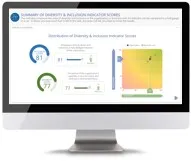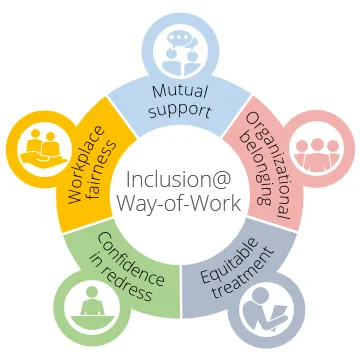
Mindset's Diversity & Inclusion Survey
Measures the contributing factors that have a direct impact on diversity and inclusion in the workplace
The clearest indicator of a successfully implemented diversity strategy is the degree that everyone, and especially members of minority groups, feel drawn in and encouraged to participate by the social dynamics within the organization.
Organizational diversity refers to the scope of biographical differences represented in an organization’s workforce. Although a wide range of personal differences may factor into an organization’s diversity strategy, areas of personal difference that many companies focus on are race/ethnicity, gender, age, sexual orientation, and religion. The reason these forms of personal difference serve as focal points for an organization’s diversity strategy is that they are historically and contemporarily related to set of underlying social and political conditions that disadvantage those who fall outside of existing norms.
Organisational diversity then is the reality of the biographical differences between members of an organisation’s workforce. A Diversity Strategy determines how well the organization establishes a context wherein people across the entire breadth of human differences within the organization can thrive at work. One component of this is ensuring that employees have the necessary support to be fully engaged in their work.
The most important component of a strategy aimed at managing the fact of human diversity, however, involves addressing the specific challenges experienced by individuals who fall outside of the demographic norms that predominate within the organization – challenges that often manifest in day to day working experience, and that produce the unspoken sense that those outside of the predominant group are not fully legitimate members of the organization.
 |
Demo version of the Inclusion@Way-of-Work diversity and inclusion dashboard (desktop only) |
Click here for more information about the Inclusion@Way-of-Work survey model.
Inclusion@Way-of-Work: Indicators of an Effective Diversity Strategy
If the outcome of a failed diversity strategy is that members of key groups feel they are excluded and held apart from their counterparts in the predominating group, the clearest indicator of a successfully implemented diversity strategy is the degree that everyone, and especially members of minority groups, feel drawn in and encouraged to participate by the social dynamics within the organization. Further, these perceptions should also be accompanied by an understanding that the organization is effectively embracing and leveraging the diversity of those within its workforce.
Indicator #1: Inclusion

Indicator #2: Diversity
A successful diversity strategy should also extend beyond the individuals personal experience of the organization, however. Employees should also come to see their organization as a whole embraces diversity and appropriately accommodates the differences across their workers so that everyone can do their best work. At the end of the day, workers are not only focused on their personal experience of the workplace— they are also concerned about the perceived conduct or image of the groups they associate themselves with. To that end, seeing their organization as one that acknowledges and supports diversity is a central component of an effective diversity strategy.
|
Book a free, no-obligation online demo of the Engage EX platform |
|
Contact us for more information or a quote for a turnkey solution |
Inclusion@Way-of-Work: Understanding the Drivers of Inclusive and Diverse Workplaces
Where indicators provide information about the state of inclusion and diversity within the organization, drivers are the factors that are the likely causes of those results. They represent both the challenges that employees are facing regarding feeling fully included in the organization, as well as the opportunities to create meaningful improvements. If indicators are there to indicate what is happening vis-à-vis the effectiveness of the current diversity strategy, the drivers are there to answer why and how those results likely came to be.
Mindset’s Inclusion@Way-of-Work diversity and inclusion model measures the contributing factors that have a direct impact on inclusion and diversity in the workplace:
- Equitable Workplace Treatment: whether or not employees report having experienced discriminatory treatment within the organization on account of their background.
- Confidence in Redress: how confident your employees feel that there are systems in place to make sure they are protected and respected while workplace conflicts are resolved.
- Foundational Fairness: the extent to which the workplace is consistently experienced as a fair place – full participation relies on a universal trust that the organization strives for fairness.
- Mutual Inclusion & Support: the degree to which employees feel encouraged to participate in the organization as fully-fledged team members – which depends on feeling safe to express oneself and encouraged to participate.
- Organizational Belonging: how strongly employees feel that they are able to see themselves in – and meaningfully identify with – the organization as an inclusive community.

